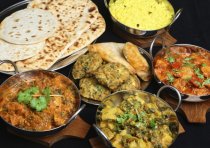Washington Post Indian food
 Indian food, with its hodgepodge of ingredients and intoxicating aromas, is coveted around the world. The labor-intensive cuisine and its mix of spices is more often than not a revelation for those who sit down to eat it for the first time. Heavy doses of cardamom, cayenne, tamarind and other flavors can overwhelm an unfamiliar palate. Together, they help form the pillars of what tastes so good to so many people.
Indian food, with its hodgepodge of ingredients and intoxicating aromas, is coveted around the world. The labor-intensive cuisine and its mix of spices is more often than not a revelation for those who sit down to eat it for the first time. Heavy doses of cardamom, cayenne, tamarind and other flavors can overwhelm an unfamiliar palate. Together, they help form the pillars of what tastes so good to so many people.
But behind the appeal of Indian food — what makes it so novel and so delicious — is also a stranger and subtler truth. In a large new analysis of more than 2, 000 popular recipes, data scientists have discovered perhaps the key reason why Indian food tastes so unique: It does something radical with flavors, something very different from what we tend to do in the United States and the rest of Western culture. And it does it at the molecular level.
Before we go further, let's take a step back and consider what flavors are and how they interact. If you were to hold a microscope to most Western dishes, you would find an interesting but not all-too-surprising trend. Popular food pairings in this part of the world combine ingredients that share like flavors, which food chemists have broken down into their molecular parts — precise chemical compounds that, when combined, give off a distinct taste.
Most of the compounds have scientific names, though one of the simpler compounds is acetal, which, as the food chemist George Burdock has written, is "refreshing, pleasant, and [has a] fruity-green odor, " and can be found in whiskey, apple juice, orange juice and raw beets. On average, there are just over 50 flavor compounds in each food ingredient.





